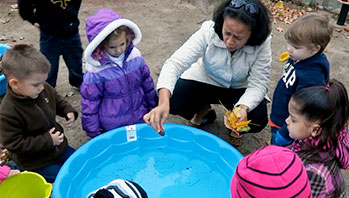- chart paper
- markers
- "We Are All Scientists" chart
- compare
- different
- same
- senses
MA Standards:
Speaking and Listening/SL.PK.MA.3: Ask and answer questions in order to seek help, get information, or clarify something that is not understood.
MA Draft STE Standards
Life Sciences/From Molecules to Organisms: Inheritance and Variation of Traits/LS1/3.B: Identify the 5 senses as ways animals (including themselves) gather different kinds of information about the world around them. [Structure and Function]
Life Sciences/From Molecules to Organisms: Inheritance and Variation of Traits/LS1/3.C: Use their sense in their exploration and play to gather information. [Structure and Function]
Head Start Outcomes:
Approaches to Learning/Initiative & Curiosity: Demonstrates eagerness to learn about and discuss a range of topics, ideas, and tasks.
Approaches to Learning/Initiative & Curiosity: Asks questions and seeks new information.
Logic & Reasoning/Problem Solving: Classifies, compares, and contrasts objects, events, and experiences.
Language Development/Expressive Language: Engages in communication and conversation with others.
Language Development/Expressive Language: Uses language to express ideas and needs.
Science Knowledge/Scientific Skills & Method: Observes and discusses common properties, differences, and comparisons among objects.
Science Knowledge/Scientific Skills & Method: Participates in simple investigations to form hypotheses, gather observations, draw conclusions, and form generalizations.
Science Knowledge/Conceptual Knowledge of Natural & Physical Worlds: Observes, describes, and discusses living things and natural processes.
PreK Learning Guidelines:
English Language Arts/Language 2: Participate actively in discussions, listen to the ideas of others, and ask and answer relevant questions.
English Language Arts/Composition 16: Use their own words or illustrations to describe their experiences, tell imaginative stories, or communicate information about a topic of interest.
English Language Arts/Composition 20: Generate questions and gather information to answer their questions in various ways.
Science and Technology/Earth and Space Sciences 5: Compare and contrast natural materials such as water, rocks, soil, and living organisms using descriptive language.
Science and Technology/Living Things and Their Environment 15: Use their senses of sight, hearing, touch, smell, and taste to explore their environment using sensory vocabulary.
EEC:
PW50: The older toddler engages in a variety of physical activities.
Explore Together (outdoors): Let’s Be Scientists!

© Commonwealth of Massachusetts, Department of Early Education and Care. All rights reserved.
Safety Tips:
- Be aware of and check areas for poison ivy, poison sumac, nettles and bushes with thorns before taking children outside.
- Remind children to wash their hands before and after the activity.
- Remind children not to eat ANY plants or touch any plants without asking an adult.
- Children’s allergies need to be taken into account before going outside.
Tell children you are going to take them for an outdoor exploration. Review the terms explore and observe. Display the "We Are All Scientist" chart to review what children learned about scientists.
While children are outside, focus their attention on something specific such as flowers or a tree. Guide children’s focus to use all their senses as they explore. For example, have them look closely to notice details, touch to compare, or listen closely to make observations. Pose questions as they observe to prompt them to expand their observations, for example,
- What color are the leaves on this tree? Why do you think the top of the leaf is a different color than the bottom of the leaf?
- Do you think the petals of the flower feel the same as the leaf?
- What do you think the flower smells like? Does it smell the way you thought it would?
- Look at these two trees. How are the leaves the same? How are they different?
Reflect and Share Together
Once inside, gather children and have them share their observations. Record children’s observations on chart paper. Ask,
- Do you have any questions about anything you saw today? How can we find out more about what you wonder about? (exploring, observing, asking questions)
- Have children draw a picture to record their observations. Tape the drawings next to each child's dictated observation on the chart.
Take It Further: Create a Venn Diagram or a graph with children to help them discuss what they observed. For example, draw a Venn Diagram to compare the leaves from two different trees they saw. Ask What were the leaves like on the first tree? What were the leaves like on the second tree? Record children’s answers in the appropriate sections of the diagram. Then point to the middle of the diagram and say, Here we can fill in the things that were the same about the leaves from both trees. What should we write here? Talk about how the diagram helped them understand what they saw.
Adaptation: For more advanced children, you may want to try to generate a logical conclusion about the observations children as you introduce seasonal changes in trees. Say, We noticed there are many leaves on the ground and they are brown. What season, or time of year do the leaves turn color and fall to the ground? Do they all fall off the tree? Are the trees full of leaves? Give generous guidance to help children make the conclusion together.
Social Emotional Tip: Encourage children to help one another and share their findings.
Social Emotional Tip: As children share and discuss their work, help them build confidence in their own ability, pride in work well done, and appreciation for the ability of others.
